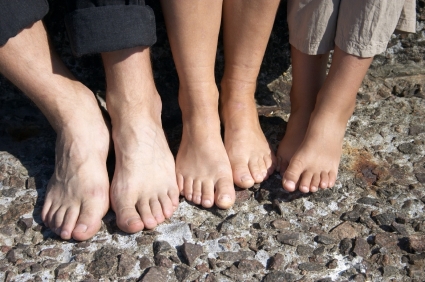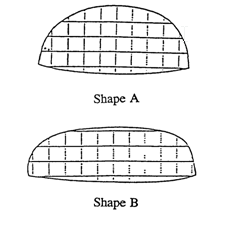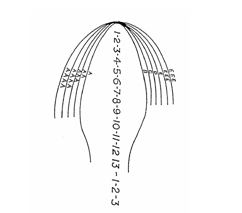The difference in length of 1/3 inch applies to men’s, women’s and children’s footwear. A problem with the system involves the way it was developed. The sizing scales for each gender are different. You can even find differences in American versus European sizing, but that different topic. Unfortunately, in America we do not start with a small number for length in children and go to the largest number for men.
Children’s sizes start at 0 and go to 13, then start over with Size 1 and usually go to 4. Men’s length sizes can start at Size 4 and normally go all the way to 16, while women’s sizes may start at 2 and go to 12 or 13. These length sizes vary, so to properly measure and fit, you should use a measuring device and inventory for the particular grouping you are fitting.
One constant you will notice in men’s and women’s sizing is the difference of two sizes. That is, on the shoe size scale comparison, a man’s 8 will be the same length as a woman’s 10. But remember that this is only toe length. When fitting, keep in mind that the lasts are probably designed differently for the male or female foot.
Issues in Measuring Width
It is important to understand that the measurement of a shoe’s width is not necessarily the measurement we take when we measure the foot with a Brannock Device. What does that mean? The measurement of a last width, or the width marking on a shoe, is the girth measurement at the ball of the foot. However, when we take a width measurement with a foot measuring devise, we are measuring the linear width of the foot at the ball.
As previously mentioned, the width measurement of the last, and thus the shoe, is a girth or volume measurement, not a linear measurement. So when you are measuring the foot you are getting only a one-dimensional measurement. That is why the foot evaluation is as important as the foot measurement. If you note during the foot evaluation that the foot is very full and fleshy or has a very high instep, you must take this into consideration when selecting the shoe width. The width you measure with the measuring device, or the linear width of the foot, may not reflect the amount of volume of the foot or the width/girth needed to properly fit the foot.
Also, when a last or shoe width changes from B to C, the change may not translate to the shoe being wider across the bottom of the shoe or foot. In fact, the linear measurement may remain the same, but the shoe is wider because it is fuller or has more material across the upper.
The difference in each width is 1/4 inch. For each change in width (B to C to D, etc.), there is 1/4 inch change in girth at the ball of the foot.
As a shoe increases in length, a 1/4 inch increase in girth occurs automatically with each increase of a full size. Remember from the section on lasts, each time a last/shoe increases in length, there is a proportional (predictable) increase in size or measurement of the ball, waist, instep and heel. For example, a woman’s size 6B many have a ball width (girth) measurement of 8 inches, while a 7B will measure 8.25 inches. Even though both are marked a B width, it stands to reason that you pick up more ball width with increased size, even though the width size remains the same.
Remember, also, that two B width shoes may have the same girth measurement while the linear measurement (on the bottom of the foot) may or may not be the same.
Some manufacturers and retailers limit the amount of their inventory investment by using less precise width markings. That is, instead of AAA, AA, B, C, D and E widths, etc., the shoes are marked Slim, Narrow, Medium, and Wide. This allows for some width selection, but does not require the store to have as much stock as the standard width markings. Often, manufacturers who use S, N, M or W width markings will identify these letters with traditional width letter sizing, such as:
Men’s: M = D width, W = E width, WW = EEE width
Women’s: N = AA width, M = B width, W = D width
However, there are no standards for the N, M, or W width markings, so the shoe fitter needs to trial fit the shoe to understand the characteristics of that manufacturer’s width markings.
Commonly, linear measurements (sole and insole) do not change for numerous widths, but girth measurements do change. Sometimes, soles are manufactured in only one width, but the soles are then fitted to shoes marked N, M, or W. For example, a differently sized upper (N or W) can be attached to a medium sole base. When this happens, the manufacturer usually uses a smaller girth measurement (less material) in “narrow” shoes and a larger girth measurement (more material) for a “wide” shoe’s upper. Be especially careful when you are fitting a foot that has a wide linear measurement. This foot needs a shoe that also has a wide linear measurement.
Working Person’s Store offers a wide range men’s and women’s boots and shoes including both safety and non-safety designs. This comprehensive selection include a variety of toe shapes and sizes, providing a array of options so you can find a pair that fits your feet perfectly.







